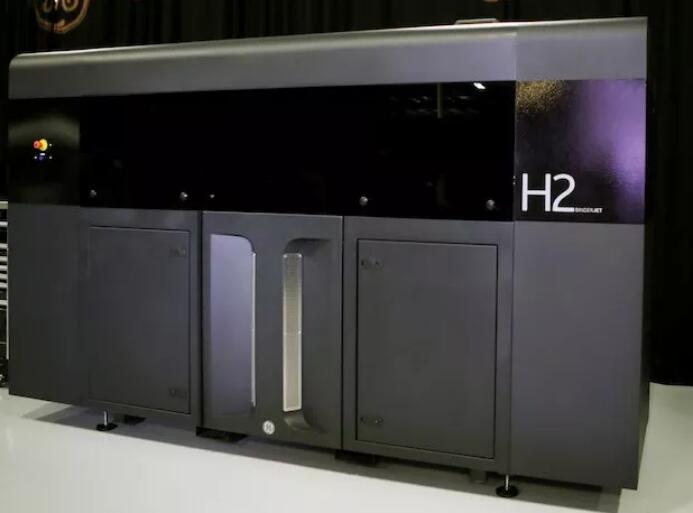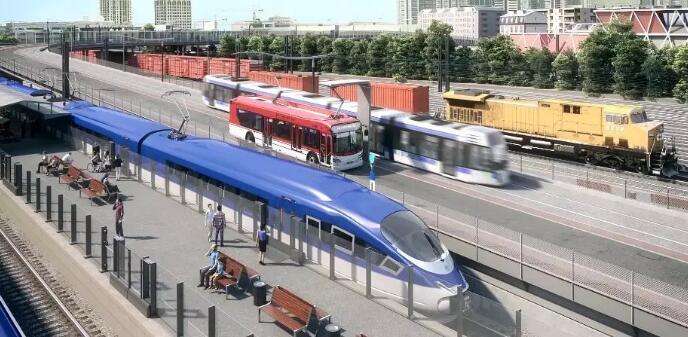In the field of transportation, through3D printingTo complete the production of spare parts is particularly advantageous for the railway locomotive and aerospace fields. Additive manufacturing has significant advantages in shortening the delivery time in the manufacture of new parts and spare parts.In some aspects, the safety requirements of trains are even stricter than that of airplanes, mainly because passengers need to travel for a long time, which puts forward high requirements on the wear resistance and stability of the parts, and the parts of the train need to meet the flame retardant Performance requirements. And it turns out that3D printingIs meeting a series of stringent parts quality requirements.
Picture: GE Binder Jet Metal3D printingH2 equipment
Westinghouse Brake-Wabtec Corporation, a global manufacturer in the railroad and transportation industries, has invested in GE’s additive manufacturing H2 bonded jet technology to expand its growing application demand in the transportation industry and establish its additive manufacturing strategy.
Picture: Westinghouse Brake-Wabtec Corporation
According to Philip Moslener, global director of platform and application innovation at WabtecOne,3D printing-Additive manufacturing technology is becoming one of the “key technical pillars” of Westinghouse Brake. With the application and promotion of GE’s binder injection technology, Westinghouse Brake is able to design and produce reliable, low-cost products for current and future developments. Cost components. By 2025, additive manufacturing can be used to produce up to 250 products within its company.According to China3D printingThe network understands that Westinghouse Brake and GE Additive Manufacturing will cooperate closely to support its industrialization strategy.Westinghouse Brake has received the first GE H2 binder sprayed metal3D printingEquipment, the machine is currently located in GE’s Additive Manufacturing Laboratory in Cincinnati, where the Westinghouse Brake team is working with GE’s team for development work and will relocate the machine to their plant in Grove, Pennsylvania later this year.
GE Additive Manufacturing announced its entry into Binder Jet Metal at the end of 20173D printingField, and launched the “H1” prototype.Throughout 2018, GE developed the second generation of H2 binder sprayed metal3D printingEquipment, and began to cooperate with many strategic partners and major customers, through the test plan to quickly promote the commercialization of its technology.
According to GE additive manufacturing, at the beginning of 2019, GE launched the H2 beta tester and partner program. GE specifically looks for partners and major customers. Westinghouse Brake is committed to mass production and regards innovation as its core competitiveness.Metal spraying through binder3D printingTechnology, American Westinghouse Brake can reliably print large and complex parts with high output and low cost, and benefit from it.Westinghouse Brake is one of the largest suppliers of railway products and services in North America. While producing a series of components for locomotives, trucks and passenger cars, Westinghouse Brake also manufactures shunting locomotives and shuttle locomotives, and provides after-sales service, including truck and locomotive maintenance. Westinghouse Brake has factories all over the world. The mission of Westinghouse Brake is to help users around the world improve the quality, reliability and productivity of their products. Its main products include:
Forward train control equipment and electronically controlled pneumatic brake products; railway electronic products, including event recorders, monitoring equipment and train terminal equipment; freight trucks and couplers; traction devices, connectors and tension regulators; and air compressors and Clothes dryer.
Its products also include track and switch products; railway brake equipment and related components; friction products composed of brake shoes and brake pads; window components for buses and subway cars, barrier-free elevators and ramps; and traction motors, and construction , Remanufacturing and overhauling commuter and conversion locomotives and transportation vehicles.
3D printingThe potential impact of technology on the product supply chain is3D printingOne of the important reasons why technology has received attention. Under the traditional model, standardized products need to be mass-produced in a specific factory, and then reach users through warehousing, logistics, and distribution. In this process, not only the production time is long, the carbon emissions are high, but also the expensive logistics costs are included.While adopting3D printingManufacturing mode, the user can submit the 3D model of the product to the nearest3D printingFactory or service center, production on demand.
Deutsche Bahn AG (Deutsche Bahn AG)-Deutsche Bahn (DB) fully implemented its3D printingStrategic plan for manufacturing spare parts. DB has identified at least one or two in each maintenance workstation3D printingExperts and determine which parts can pass3D printingTechnology benefits.It turns out that there are many train parts suitable for3D printing, Including spare parts for coffee machines, external hooks, steering wheel covers, headrest frames, Braille road signs for blind travelers, etc.
DB is not limited to using one3D printingTechnology, they have discovered the different advantages of plastic and metal additive manufacturing.Pass and specialize in3D printingWith the cooperation of the company, Deutsche Bahn has been able to use the most advanced additive manufacturing technology instead of investing in the equipment itself.And in the bond metal with GE additive manufacturing3D printingOn the other hand, in addition to Westinghouse Brake, Cummins also became the first batch to adopt GE indirect metal3D printingTechnology partners.Cummins plans to accelerate its use in its production process3D printing-Additive manufacturing technology, more comprehensive implementation of Industry 4.0 technology to improve automation, cloud computing and other processes in its workflow. Cummins initially used the additive manufacturing process to produce small batches of parts, and gradually explored how to integrate this technology into mass production.
(Editor in charge: admin)




0 Comments for “Westinghouse Brake invests in GE’s binder jet 3D printing technology for railway applications”